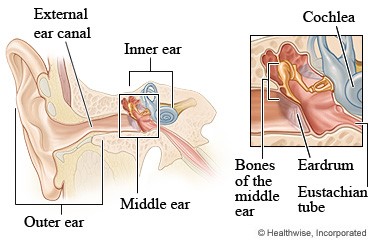Hearing Technology: Learning about


What is hearing technology?
Hearing technology refers to devices, like hearing aids, that make it possible for people to hear better. Hearing technology doesn't restore hearing to normal, but it can make it easier to communicate and participate more fully in everyday life.
When you have a hearing loss, using hearing technology helps get sound to your brain. Different types of hearing technology get sound to your brain in different ways.
What are the types of hearing technology?
There are different types of hearing technology. Today’s hearing technology uses advanced computer chips to process sound and make hearing easier. Many types of hearing technology are designed to play sound from TVs, phones, and other Bluetooth devices directly to your hearing device. Today, most hearing technology is rechargeable and water resistant.
Hearing aids
Hearing aids make speech and other sounds louder. They can fit in the ear or behind the ear. They are customized to your individual hearing loss and ear shape. Hearing aids automatically adjust to work best in different situations (sound environments). They can be controlled with a remote or from a smart phone.
There are different styles of hearing aids:
- A behind-the-ear (BTE) or receiver-in-the-canal (RIC) hearing aid connects to an ear mould or to a plastic tip inside the ear canal. These hearing aids are used for most categories of hearing loss. Ear tips and ear moulds that don’t fit well can cause a whistling sound (feedback). A buildup of earwax can also cause feedback. Your audiologist (hearing specialist) can help with these issues and make sure that your hearing aid is comfortable and fits well.
- An in-the-ear (ITE) or in-the-canal (ITC) hearing aid fits in the ear canal. These devices are small and can be damaged by earwax and fluid draining from the ear. Their small size may be hard for some people to handle. Talk to your audiologist to see if ITE or ITC hearing aids are right for you.
Bone conduction hearing device (BCHD)
A bone conduction hearing device is a hearing technology that picks up sound and transmits it through the skull to the inner ear. This type of hearing technology can be worn on a headband or permanently implanted in the skull bone and used with a sound processor that you wear. This hearing technology may be recommended when there is a problem in the middle ear and a person can’t benefit from hearing aids.
Cochlear implant (CI)
Cochlear implant is a hearing technology that stimulates the hearing nerve directly. This type of hearing technology includes the use of a sound processor that is worn on the ear and head. It transmits sounds to an electrode that is implanted in the inner ear. This hearing technology is recommended for people with severe and profound hearing loss when hearing aids are not strong enough.
Where can I get hearing technology?
In Alberta, hearing aids for adults are provided and fitted by audiologists or hearing aid practitioners in private practices. They will do a hearing test and help you decide which type and style of hearing aid may be best for you.
In Alberta, teams of specialists will determine if you are eligible for bone conduction hearing devices or cochlear implants. Talk with your audiologist or family doctor if you want to know if one of these hearing technologies is best for your type of hearing loss.
How much does hearing technology cost?
The cost of hearing technology can vary depending on the type of sound processing, accessories, and other services and warranties that are included. Talk to your audiologist or hearing aid practitioner to learn more.
In Alberta, if you are eligible for support, Alberta Aids to Daily Living provides funding for hearing technology.
If you have a private health insurance plan (like Alberta Blue Cross), find out what’s covered. Some insurance plans cover the cost of hearing aids.
Learn more in our guide to buying hearing aids for adults.
To see this information online and learn more, visit https://MyHealth.Alberta.ca/health/AfterCareInformation/pages/conditions.aspx?hwid=custom.ab_hearingaid_technology_inst.

For 24/7 nurse advice and general health information call Health Link at 811.
Current as of: November 4, 2022
Author: Provincial Audiology Professional Practice, Alberta Health Services
This material is not a substitute for the advice of a qualified health professional. This material is intended for general information only and is provided on an "as is", "where is" basis. Although reasonable efforts were made to confirm the accuracy of the information, Alberta Health Services does not make any representation or warranty, express, implied or statutory, as to the accuracy, reliability, completeness, applicability or fitness for a particular purpose of such information. Alberta Health Services expressly disclaims all liability for the use of these materials, and for any claims, actions, demands or suits arising from such use.
